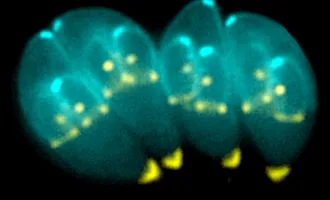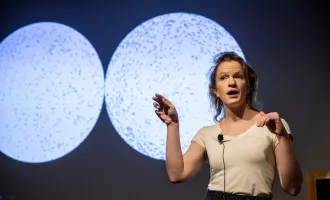Journal Club: Immunology, Cell Biology, Genetics, and Cell Biology
IMMUNOLOGY: Cell-based Measures of Viral Persistence Are Associated with Immune Activation and PD-1 Expressing CD4+ T cells. Hatano, H. et al. (Deeks). Journal of Infectious Disease. October 22. [Epub ahead of print]
In patients being actively treated with highly active anti-retroviral therapy (HAART), HIV persists in CD4+ T-cells; it evades detection from the immune system, causes chronic stress that can lead to cell death or dysfunction, and can even make the T-cell tolerant to the presence of HIV. This leads to viral persistence despite long-term treatment. Cellular markers of chronic stress and/or tolerance can be used to detect persistence and help decide treatment options. However, detailed analysis of the cells from blood can be cumbersome.
Here, researchers in the McCune laboratory identified PD-1 as a marker of persistent latent HIV infection in patients that have undergone long-term HAART. PD-1 is a marker of T-cell dysfunction, and cells expressing PD-1 had high levels of HIV DNA, making it a straightforward, functional marker of latent infection and immune dysfunction.
CELL BIOLOGY: Divergent allosteric control of the IRE1α endoribonuclease using kinase inhibitors. Wang, L. et al. (Maly). Nature Chemical Biology. October 21. [Epub ahead of print]
The unfolded protein response is the cell’s way of dealing with potentially harmful levels of proteins accumulating in the endoplasmic reticulum of the cell. In some familial strains of Alzheimer’s, a genetic mutation causes the unfolded protein response to be turned down and contributes to harmful amyloid in the cells of the brain. Understanding the specific molecular players in the unfolded protein response may lead to the development of drugs that can enhance this response in diseases such as Alzheimer’s or cancer, where cells are also stressed. IRE1α becomes activated upon accumulation of unfolded proteins and initiates splicing of XBP1 mRNA, which begins the unfolded protein response.
Here, researchers describe how IRE1α can be artificially manipulated into activated or inactivated conditions with novel small molecule ligands. With these newly identified small molecules, researchers will be better able to manipulate the unfolded protein response and study diseases related to protein accumulation.
CELL BIOLOGY: Subdiffraction-resolution fluorescence microscopy reveals a domain of the centrosome critical for pericentriolar material organization. Mennella, V. et al. (Agard). Nature Cell Biology. 14(11):1159-68.
The centrosome is the part of the cell from which microtubules originate and is the cell’s central scaffolding. The centrosome contains the centrioles, which assist in orientation of microtubules, surrounded by a protein-dense area of pericentriolar material (PCM). This material provides a good anchor for microtubule growth, but the structure of this region has been difficult to determine. Here, researchers used a new method of microscopy to view these structures.
Overall, they found that proteins in the PCM are organized into two main structures: one nestled against the centriole and one extending outwards. They identified the orientation of protein structures within the PCM and closely examined pericentrin-like protein (PLP), which they identified as critical in mitosis through RNA interference.
GENETICS: A global DNA methylation and gene expression analysis of early human B-cell development reveals a demethylation signature and transcription factor network. Lee, S.T. et al. (Wiemels). Nucleic Acids Research. October 16. [Epub ahead of print]
Epigenetics refers to changes in gene expression that are not due to changes in underlying DNA sequences; for example, the presence or absence of methyl-groups on the histones that wind DNA into coils can influence the ability of a DNA sequence to be expressed. DNA methylation status is one way that epigenetic modifications influence gene expression; therefore, studying changes in methylation status can teach us about underlying changes in gene transcription.
In this paper, researchers examined the methylation status of developing human B-cells and found that progenitors are overall more demethylated compared to committed B-cells. These findings provide a comparison for further studies of B-cell leukemias.
CELL BIOLOGY: Mechanism of fatty-acid-dependent UCP1 uncoupling in brown fat mitochondria. Fedorenko, A.; Lishko, P.V.; Kirichok, Y. Cell. 151(2):400-13.
White fat is the type of fat we try to avoid accumulating — cells contain a large fat droplet that can be broken down into energy-rich fatty acids upon release of glucagon from the pancreas. Brown fat is very different: it doesn’t accumulate with overeating, the cells contain many smaller fat droplets, and it is actually more closely related to muscle than to white fat. Brown fat cells contain huge numbers of mitochondria that turn energy from fat into heat. It is essential for newborns to keep warm and in many mammals, for hibernation.
Mitochondrial uncoupling protein 1 (UCP1) is responsible for brown fat heat generation by increasing the conductance of the mitochondrial membrane, but how exactly this is accomplished was unknown. Here, researchers discovered that long-chain fatty acids released by lipid droplets bind to MUP1 and facilitate constitutive transport of hydrogen cations across the mitochondrial membrane. This constant transport allows for dissipation of an ion gradient across the membrane, which favors the production of heat energy.


